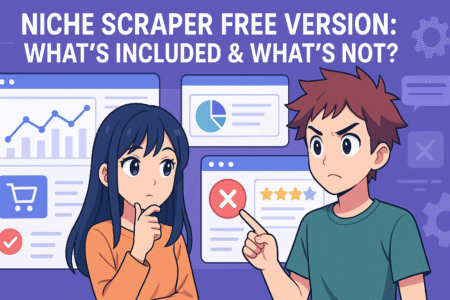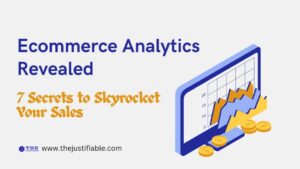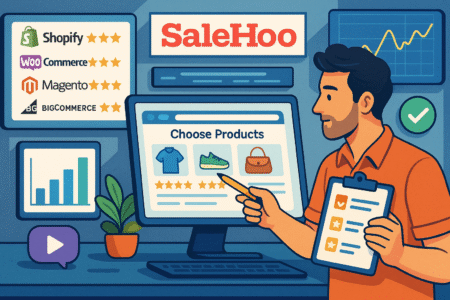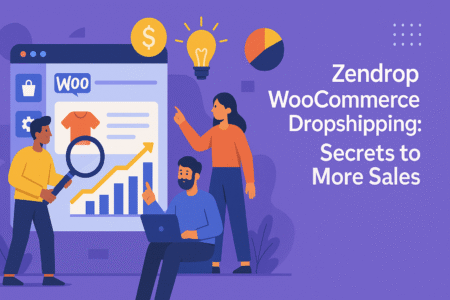Table of Contents
Are you wondering what makes AppScenic a top pick among ecommerce store owners? Could this platform really simplify your dropshipping business while boosting your profits?
In this AppScenic review, we’ll uncover the key features, benefits, and why so many online sellers swear by it. From seamless product sourcing to automated fulfillment, you’re about to find out if AppScenic could be your next game-changer. Ready to explore? Let’s dive in!
Introduction to AppScenic: Key Benefits Unveiled
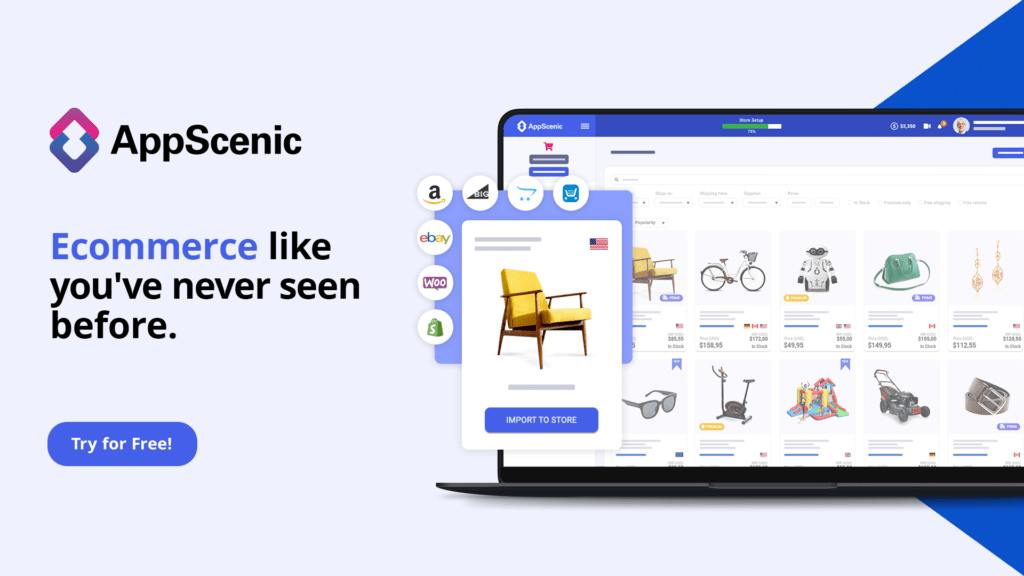
AppScenic is making waves in the ecommerce world, and there’s a good reason for that. With its robust features designed to simplify dropshipping and product sourcing, this platform is helping store owners save time, boost revenue, and stay ahead of competitors. Let’s take a closer look at what AppScenic offers and why it’s becoming a favorite among online retailers.
What Is AppScenic and Why It’s Gaining Popularity
AppScenic is a powerful platform designed for ecommerce store owners to connect with reliable suppliers and manage product listings seamlessly. It focuses on automating time-consuming tasks such as order fulfillment, inventory management, and pricing adjustments—all while ensuring that store owners maintain full control. But what’s causing this sudden surge in popularity?
For many, the appeal lies in AppScenic’s ability to provide access to a wide range of high-quality suppliers globally. This is crucial for dropshippers who often face challenges like unreliable suppliers or limited product variety. With AppScenic, users can source products confidently, knowing they’re backed by verified partners.
Additionally, the platform’s automation features minimize the manual labor involved in processing orders, keeping things running smoothly even during peak sales periods. Users have found it to be a major game-changer in scaling their businesses without the usual headaches. Imagine focusing on marketing and growth while AppScenic handles the backend—sounds like a win, right?
The combination of convenience, efficiency, and access to a broad supplier network explains why AppScenic is quickly becoming a go-to choice for ecommerce owners worldwide.
Core Features That Set AppScenic Apart from Competitors
AppScenic offers several standout features, making it a preferred choice over traditional dropshipping platforms. Here’s what sets it apart:
- Automated Order Processing: Once a customer places an order, AppScenic takes care of the rest by instantly routing the order to the supplier and keeping you updated on its status. This reduces errors and speeds up the process.
- Real-Time Inventory Syncing: No more overselling or listing out-of-stock products. AppScenic syncs inventory automatically so you always know what’s available.
- Global Shipping Options: Whether your customers are local or international, AppScenic ensures they receive their orders quickly through reliable shipping partners.
- Dynamic Pricing Tools: AppScenic’s pricing automation helps you maintain competitive margins by automatically adjusting prices based on supplier costs or other criteria.
These features aren’t just useful—they directly impact profitability and efficiency. For example, with real-time syncing, you won’t risk upsetting customers by selling products that are no longer in stock. Meanwhile, the automated order routing lets you serve more customers without the need for extra staff.
What’s more, its dynamic pricing options give you the flexibility to protect your profit margins automatically. Whether costs change due to shipping fees or supplier price fluctuations, you can set rules to adjust retail prices accordingly. This feature alone can save you hours of manual adjustments and help you maintain steady growth.
Why Ecommerce Owners Are Flocking to AppScenic
For ecommerce store owners, AppScenic isn’t just a tool—it’s a solution to their most common pain points. Many sellers are turning to this platform to solve issues like:
- Inconsistent suppliers who cause delays or provide poor-quality products
- Time-consuming manual processes that leave little room for growth
- Inventory mismanagement, leading to canceled orders and dissatisfied customers
What sets AppScenic apart is how effectively it addresses these challenges. For example, dropshipping store owners often juggle multiple suppliers, which can be overwhelming when managing stock levels or fulfilling orders. AppScenic eliminates this complexity through its centralized dashboard, giving you a complete overview of orders, inventory, and supplier updates in one place.
Ecommerce owners also appreciate the platform’s ability to help them scale without the usual stress. When orders flood in during busy periods, they don’t have to worry about bottlenecks or delayed deliveries. Instead, they can focus on growth-oriented tasks like improving marketing campaigns or optimizing product listings.
Plus, AppScenic’s supplier verification process ensures that sellers can trust the partners they work with. You won’t have to constantly worry about poor-quality products or refunds due to supplier issues. Instead, you can confidently provide customers with what they expect—and build a reputation for reliability along the way.
🛠️ Pro Tip: For ecommerce owners struggling with time management, AppScenic’s automation can be a game-changer. Set up inventory syncing, order fulfillment, and price monitoring to run automatically, and watch how much time you save!
How AppScenic Enhances Dropshipping Success
AppScenic isn’t just a platform—it’s a tool designed to transform how ecommerce store owners run their dropshipping businesses. With a combination of automation, supplier integration, and profit-focused features, it eliminates the common barriers to scaling a successful online store.
Streamlined Supplier Integration for Seamless Product Import
AppScenic makes sourcing products as simple as a few clicks, and that’s a major relief for ecommerce owners who have struggled with complicated supplier onboarding in the past. The platform connects you to verified suppliers, ensuring the products you import meet quality standards without the need for constant manual checks.
Imagine you’re building your online store and want to add a new product category. With AppScenic’s supplier marketplace, you can browse thousands of products and instantly import them into your store without worrying about formatting issues. It even allows you to filter products based on shipping regions, availability, and profit potential. This means you’re not wasting time on products that don’t align with your goals.
The streamlined import process also reduces errors. Instead of manually inputting product descriptions, pricing, and stock quantities, AppScenic syncs this information automatically. This not only saves time but prevents costly mistakes, like listing incorrect prices or outdated product details.
If you’ve dealt with unreliable suppliers before, you’ll appreciate AppScenic’s supplier vetting process. Each supplier is verified, minimizing the risk of receiving poor-quality goods or late shipments. This peace of mind is invaluable, especially when scaling your store.
Real-Time Inventory and Automated Order Fulfillment
Managing inventory can be one of the most frustrating parts of running a dropshipping store. Stock levels change frequently, and without real-time updates, you risk overselling products or disappointing customers. AppScenic solves this issue with automatic inventory syncing that keeps your store up to date 24/7.
When a supplier’s stock changes, AppScenic automatically reflects this in your store. This way, you’re always selling products that are actually available. No more manual updates or angry customer emails asking why their order was canceled.
Order fulfillment is just as efficient. As soon as a customer places an order, it’s automatically routed to the supplier. You’ll get tracking updates directly through the platform, so you can provide customers with timely delivery updates. This process takes the guesswork out of fulfillment and lets you focus on marketing and growth instead of logistics.
In my experience, this kind of automation is essential when you’re scaling a store. You won’t have to worry about orders slipping through the cracks or scrambling to restock popular items.
Global Shipping Options with Fast Delivery Times
Shipping can make or break an ecommerce business. Customers expect fast, reliable delivery, and failing to meet these expectations often leads to bad reviews and lost sales. AppScenic helps you stay competitive with global shipping options that are fast and affordable.
Unlike many traditional dropshipping platforms that rely on long delivery times from overseas suppliers, AppScenic offers access to warehouses and suppliers in multiple regions. This allows you to ship products faster, sometimes within a few days instead of several weeks.
For example, if you’re targeting customers in the U.S., you can choose suppliers with local warehouses to ensure quicker delivery. This flexibility is great for reducing cart abandonment, as customers often decide to buy based on estimated delivery dates. Faster delivery also translates to fewer support tickets and complaints, giving you more time to focus on scaling.
Additionally, AppScenic’s shipping partners are reliable, so you won’t be left wondering where your customers’ packages are or dealing with lost shipments.
Built-in Price Markups and Profit Optimization Tools
Maintaining profitability in dropshipping can be tricky, especially with fluctuating supplier costs and shipping fees. That’s where AppScenic’s dynamic pricing tools come into play. These features help you set automated price markups, ensuring you maintain healthy profit margins without constant manual adjustments.
For example, let’s say a supplier increases their product price due to high demand. AppScenic will automatically update your retail price based on your predetermined rules, so you’re not caught off guard. Similarly, if a supplier offers a discount, your store’s prices can be adjusted to reflect the savings, helping you attract more customers.
The platform also allows you to set tiered pricing, offering discounts for bulk orders or incentivizing repeat purchases. With built-in analytics, you can track which products yield the highest profits and adjust your strategies accordingly.
This feature is especially helpful for store owners looking to grow their revenue while minimizing manual work. Instead of constantly monitoring costs and calculating markups, you can set it up once and let AppScenic handle the rest.
🚀 Best Practice: Set smart price rules that account for supplier changes, shipping fees, and desired profit margins. This ensures you’re never selling at a loss and can adjust pricing to match market demand automatically.
AppScenic’s User-Friendly Interface and Setup Process

Getting started with AppScenic is easier than you might expect. The platform’s clean design, intuitive dashboard, and customizable options make it a favorite among ecommerce owners who want simplicity without sacrificing functionality. Let’s walk through the setup and key interface features that ensure a smooth user experience.
Step-by-Step Setup: Getting Started on AppScenic
When you sign up for AppScenic, the platform guides you through an easy onboarding process that doesn’t require any technical expertise. From creating your account to connecting your online store, every step is designed to minimize confusion and save time.
Once you’ve registered, the system prompts you to link your store. AppScenic currently supports major platforms like Shopify and WooCommerce, making integration smooth. All you need to do is grant permissions, and AppScenic will automatically sync your store’s details. This step ensures your product listings, orders, and inventory updates are all managed from a central hub.
Next, you’ll gain access to the supplier marketplace, where you can browse and import products effortlessly. You can filter items based on category, location, and availability. Whether you’re selling fashion, home décor, or electronics, the import feature ensures the products fit your niche without the hassle of manual uploads.
After importing your first set of products, you can explore additional settings to customize prices, shipping options, and descriptions. Within a few clicks, your store is ready to start selling without you spending hours on backend tasks.
Intuitive Dashboard for Easy Navigation and Management
A confusing dashboard can be a nightmare, but AppScenic’s design is the opposite. The platform features a clean, well-organized dashboard that places all the essential tools right at your fingertips. Whether you’re tracking orders, checking supplier updates, or monitoring profits, everything is neatly categorized for ease of use.
One standout feature of the dashboard is its visual appeal. You’re greeted with charts and graphs that provide quick insights into sales trends, order statuses, and stock levels. Instead of sifting through pages of data, you can access important metrics with a glance. This saves time and helps you spot opportunities for growth.
For example, the “Order Management” tab consolidates all your current orders, highlighting their fulfillment stages. Need to follow up on a delayed order? You can do so directly from the dashboard without opening multiple tabs or searching through emails.
Another helpful feature is the built-in notifications system. You’ll receive alerts when inventory levels are low or when supplier updates might impact your listings. This proactive approach ensures you’re always ahead of potential issues.
Customizable Settings for Product Listings and Syncing
One of AppScenic’s most valuable features is its customizable settings for product listings and syncing. Instead of rigid, one-size-fits-all configurations, you can adjust settings to match your store’s needs and branding preferences.
For product listings, you’re free to edit descriptions, titles, and images to make them more appealing to your target audience. You don’t have to stick to the supplier’s default details, which is a common limitation in many dropshipping platforms. This flexibility allows you to create compelling listings that boost conversions.
Pricing customization is another area where AppScenic shines. You can set pricing rules to automatically apply markups, discounts, or promotions based on supplier costs. For example, if you want to maintain a consistent 30% profit margin, the platform will handle price adjustments whenever supplier costs change. This prevents pricing errors and ensures you maintain profitability without manual oversight.
Product syncing is equally seamless. When suppliers update their stock, AppScenic automatically reflects the changes in your store, so you never risk selling out-of-stock items. Similarly, if a supplier discontinues a product, it’s automatically delisted from your store.
With these settings in place, you won’t have to micromanage your listings. Instead, you can focus on growth-oriented activities like running marketing campaigns and expanding your product range.
🚀 Best Practice: Customize product descriptions and images to match your brand’s tone and style. Personalized listings are more likely to convert compared to generic supplier content.
AppScenic’s Integration with Popular Ecommerce Platforms
AppScenic integrates effortlessly with some of the most popular ecommerce platforms, making it easier for store owners to streamline their business processes. Whether you’re using Shopify, WooCommerce, or considering expansion through APIs, AppScenic ensures you maintain full control of your store with minimal effort.
Shopify Integration: How It Works with AppScenic
For ecommerce owners using Shopify, AppScenic offers a plug-and-play solution that makes product sourcing, inventory updates, and order fulfillment a breeze. Once connected, the integration enables a seamless flow of data between your Shopify store and AppScenic’s backend system.
To get started, all you need is a few clicks to link your Shopify account, and you’ll be ready to import products directly from AppScenic’s marketplace. Every product, including descriptions, images, and prices, syncs automatically, so you don’t have to waste time formatting or correcting details. This setup reduces errors and ensures that your product pages look professional right from the start.
AppScenic’s integration with Shopify also means that real-time inventory syncing works effortlessly. If a supplier updates stock levels or prices, your store reflects these changes instantly. This helps prevent overselling or pricing inconsistencies that could hurt your reputation.
Order fulfillment is another highlight. As orders come through your Shopify store, AppScenic automatically routes them to the supplier, tracks the shipping status, and updates you along the way. You can sit back and focus on marketing while the fulfillment process runs in the background.
For many store owners, this integration has been a game-changer. With minimal manual input, they’ve been able to scale operations and serve larger audiences without missing a beat.
WooCommerce Compatibility: Boosting Store Efficiency
If you’re running your ecommerce store through WooCommerce, AppScenic provides robust compatibility that makes managing your store much easier. WooCommerce, known for its flexibility, pairs well with AppScenic’s automation and product management tools.
Setting up AppScenic with WooCommerce is simple. Once connected, you can browse AppScenic’s supplier network and import products directly to your online store. The platform handles the heavy lifting by pulling in accurate product information, so you won’t need to spend hours on manual uploads.
WooCommerce users especially benefit from AppScenic’s automatic stock updates and price syncing. If a supplier’s product goes out of stock or changes pricing, your store reflects the changes in real time. This reduces the risk of customer complaints due to canceled orders and ensures your margins remain protected.
One of the most appealing features is automated order fulfillment. With AppScenic, orders placed through WooCommerce are automatically sent to the correct supplier without you needing to lift a finger. You’ll also receive tracking updates, allowing you to keep customers informed and satisfied with timely shipping notifications.
This integration helps WooCommerce users overcome common bottlenecks like order delays and manual inventory checks, providing them with more time to focus on growing their business.
Expanding to New Platforms: AppScenic’s Versatile APIs
AppScenic doesn’t limit you to popular ecommerce platforms. With its versatile APIs, you can expand your operations to custom-built stores or other ecommerce solutions. This flexibility is perfect for store owners who want to build a more personalized or niche ecommerce experience.
Through AppScenic’s API connections, you can integrate the platform into virtually any online store, whether you’re using a lesser-known ecommerce platform or a custom solution tailored to your business needs. This flexibility allows you to enjoy the same benefits—real-time inventory management, product syncing, and automated fulfillment—without needing to migrate to a mainstream platform.
For example, if you’re running a large-scale ecommerce store with multiple sales channels, the API ensures that all platforms communicate efficiently. You can centralize product sourcing and order processing, making it easier to manage different storefronts from one dashboard.
Expanding through APIs also means you won’t outgrow AppScenic. Whether you want to launch a secondary niche store or test new product categories on another platform, you can maintain efficiency without rebuilding your entire workflow.
🛠️ Pro Tip: If you’re planning to expand your business across multiple channels, set up API-based integrations early. This ensures your processes remain scalable, and you can easily adjust to new market demands.
Inventory Management and Automation Capabilities
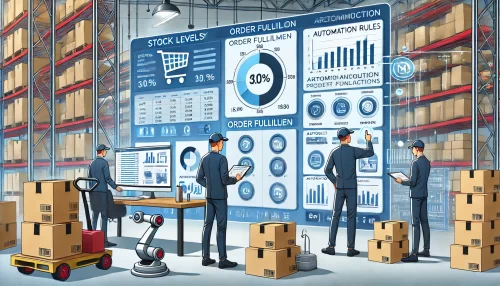
Managing inventory can be a nightmare without the right tools. AppScenic’s automation ensures store owners always have updated product availability, helping them avoid costly errors like stockouts, overselling, or delayed orders. Let’s break down how its inventory management features work to protect your profits.
Real-Time Stock Updates Across Multiple Stores
Nothing frustrates customers more than placing an order only to be told the product is out of stock. AppScenic eliminates this issue through real-time inventory synchronization, ensuring that product availability across all your sales channels is always accurate.
When a supplier updates their stock, your store reflects the changes almost instantly. Whether you’re running one store or several, AppScenic’s system ensures that all connected platforms are in sync. This is particularly valuable for store owners who sell on multiple ecommerce platforms like Shopify, WooCommerce, or custom websites. You won’t have to manually check inventory levels or update products—AppScenic takes care of it.
Think about the time you could save. Instead of logging into various dashboards or manually adjusting stock, you can rely on AppScenic’s centralized inventory management. This means you can avoid overselling products that are no longer available or missing opportunities to restock best-sellers before they run out.
Store owners who have implemented this feature report a noticeable decrease in canceled orders and improved customer satisfaction. When customers know they’re buying in-stock products, trust in your store increases, encouraging repeat business.
Automated Order Routing and Supplier Notifications
Once an order is placed, speed and accuracy are crucial to ensuring that customers receive their products on time. With AppScenic’s automated order routing, you don’t need to manually confirm or contact suppliers—everything is handled automatically.
As soon as a customer checks out, the order is automatically routed to the correct supplier, who receives a notification to begin processing it. This automation eliminates the delays that often occur with manual order fulfillment, reducing errors and speeding up shipping times.
For example, if you’re working with multiple suppliers across regions, AppScenic ensures the order is sent to the nearest available warehouse or the supplier with sufficient stock. This process keeps your fulfillment chain optimized and cost-effective. Even better, you’ll receive real-time updates on order statuses, so you’re always in the loop without needing constant follow-ups.
Store owners benefit greatly from this hands-off approach, as it allows them to focus on marketing and scaling instead of getting bogged down in logistics.
Preventing Stockouts and Overselling with Smart Alerts
One of the most common issues faced by ecommerce owners is overselling products that aren’t in stock. This not only leads to order cancellations and refund requests but can also damage your reputation. AppScenic’s smart alert system is designed to prevent such problems before they occur.
Whenever a product reaches a low-stock threshold, AppScenic triggers an alert, giving you ample time to reorder from suppliers or pause product listings temporarily. These alerts help prevent stockouts, ensuring that you never sell what you can’t deliver. You can even customize alert thresholds based on your sales patterns, allowing you to be proactive in managing inventory.
Let’s say a product in high demand is down to its last few units. Instead of waiting until the stock depletes, AppScenic alerts you so you can restock quickly or adjust your marketing strategy. This feature is especially helpful during peak shopping seasons when products sell out faster than usual.
Additionally, if a product becomes unavailable from one supplier, AppScenic can redirect the order to an alternative supplier if one is available. This level of flexibility means you can continue serving customers without disruption, even during unexpected changes.
📌 Pro Tip: Set low-stock alerts to trigger automatically when inventory hits a certain percentage of daily sales volume. This ensures you always have buffer stock, reducing the risk of missing out on revenue.
AppScenic’s Pricing Model: Is It Worth the Investment?
When choosing any platform, pricing is often a key deciding factor. AppScenic’s pricing structure is designed to accommodate a variety of ecommerce businesses, from those just starting to established stores seeking to scale. But is it worth the investment? Let’s explore what’s included in their pricing and how it impacts your bottom line.
AppScenic’s Pricing Plans Explained
AppScenic offers tiered pricing plans, giving users the flexibility to choose a package that fits their business needs. These plans typically range from a free plan for beginners to premium options designed for businesses handling high volumes of orders and advanced automation.
The free plan is ideal for small-scale dropshippers who want to test the platform before committing financially. It allows access to basic product imports and a limited number of suppliers, which is great for gaining experience without upfront investment. However, for those who need more robust features—like automated order fulfillment, real-time inventory management, or integrations with multiple ecommerce platforms—moving to a paid plan is essential.
Paid plans offer perks such as advanced automation, priority access to verified suppliers, and enhanced analytics tools. Higher-tier packages often include faster support, which can be invaluable for handling time-sensitive issues during peak sales periods.
AppScenic’s pricing model ensures that as your business grows, you can upgrade plans without disruption, scaling your access to additional tools as needed.
What’s Included in Free vs. Paid Plans
The key difference between AppScenic’s free and paid plans comes down to functionality and scalability. The free plan is designed to help new users get their feet wet without committing to an immediate investment, making it ideal for those experimenting with dropshipping or starting a side hustle.
Here’s what you can expect with the free plan:
- Basic product import and supplier browsing
- Limited access to AppScenic’s supplier network
- Basic inventory syncing
For many ecommerce owners, the free plan is perfect for testing product ideas or setting up a small store. However, scaling beyond this requires a paid plan, where you unlock critical features like:
- Automated order processing that reduces manual tasks
- Real-time inventory updates to avoid stockouts and overselling
- Global shipping options to reach a broader audience
- Dynamic pricing tools to protect profit margins
These differences are what make paid plans worth considering for long-term business growth. As your store expands, automating tedious processes like order fulfillment or price updates can free up valuable time and minimize errors.
Return on Investment: Evaluating AppScenic’s Cost vs. Value
Investing in AppScenic’s paid plans isn’t just about gaining access to more features—it’s about leveraging those tools to increase profits while reducing operational headaches. So, how do you calculate whether it’s worth the cost?
One of the key ways to evaluate the return on investment (ROI) is through saved time. Imagine spending hours daily on order fulfillment, manual price updates, or stock monitoring. With AppScenic’s automation, those tasks take care of themselves, allowing you to focus on higher-value activities like marketing and customer engagement.
You should also factor in the potential revenue boost from AppScenic’s built-in pricing tools. Dynamic pricing adjustments help you maintain healthy profit margins by automatically updating prices when supplier costs change. This ensures you’re never caught selling at a loss or missing out on higher profits during demand surges.
Additionally, the platform’s global supplier access means you can source products at competitive rates, increasing your overall profit potential. Reliable suppliers help prevent costly delays, reducing refund requests and negative customer feedback.
For many users, the cost of a paid plan is quickly recouped through the combined benefits of automation, streamlined operations, and enhanced revenue opportunities. Users who upgrade typically report improved productivity, fewer errors, and increased customer satisfaction.
💡 Expert Tip: If you’re on the fence about upgrading, start with the free plan and track how much time you spend on manual tasks. If automation could cut that time in half, upgrading may be worth it. Investing early in streamlined processes can help you scale faster while staying organized.
Customer Support and User Experience

A platform’s effectiveness often goes beyond features—how it supports users and handles issues can make or break the experience. AppScenic’s strong focus on responsive customer service and smooth usability is one reason many ecommerce owners rely on it.
Available Support Channels and Response Times
When running an ecommerce store, any delay in resolving an issue can result in lost sales or frustrated customers. AppScenic addresses this with multiple support options and fast response times, ensuring users get the help they need quickly.
You can reach their support team through live chat, email, or ticket submission. Many users appreciate the 24/7 live chat support, which provides real-time solutions to urgent problems. Whether it’s a question about product syncing or a supplier delay, live chat agents offer timely responses without making users wait for emails.
For less urgent concerns, the ticket-based system is ideal. It allows you to explain the problem in detail, and AppScenic’s team typically responds within a few hours, depending on your plan level. Paid users with higher-tier subscriptions often benefit from priority support, which ensures their tickets are handled even faster.
AppScenic’s help center is another useful resource. It offers step-by-step guides, FAQs, and video tutorials, making it easy to troubleshoot common problems without needing to contact support. This self-service option saves time and empowers users to find solutions independently.
From what I’ve seen, the combination of live chat, email, and detailed guides covers most user needs. Knowing you have multiple options for support provides peace of mind, especially when facing technical glitches or supplier-related issues.
User Reviews: What Ecommerce Owners Love About AppScenic
AppScenic receives high praise from ecommerce owners, primarily for its user-friendly design and reliable automation features. Many users highlight how the platform reduces their workload, allowing them to focus on marketing, product research, and customer engagement.
For small business owners, the platform’s automation capabilities are a major draw. Tasks that would typically take hours—like syncing product details or managing orders—are completed seamlessly in the background. One user mentioned how they were able to double their product listings without hiring additional staff, all thanks to AppScenic’s automated fulfillment system.
Another common theme in reviews is the platform’s smooth integration with Shopify and WooCommerce. Users often mention how they experienced minimal setup issues and found it easy to import products and start selling right away. The intuitive dashboard, which provides clear insights into order statuses and stock availability, is also frequently praised.
Customers also appreciate AppScenic’s wide supplier network and the platform’s ability to connect them with reliable, high-quality vendors. This reduces the risk of selling low-quality products and ensures faster order deliveries, which translates into better customer satisfaction.
When reviewing the platform, many users point to its scalability. As businesses grow, they can rely on AppScenic’s tools to handle increasing order volumes, giving them confidence to expand without operational concerns.
Common Complaints and How AppScenic Resolves Them
Like any platform, AppScenic isn’t without its challenges. Some users, especially those new to ecommerce, have expressed concerns about the learning curve when using certain advanced features, like dynamic pricing rules or API integrations. However, AppScenic addresses this through its detailed knowledge base and responsive support team.
In my experience, platforms like this can feel overwhelming at first, but AppScenic’s onboarding process helps bridge that gap. New users have access to setup guides, video tutorials, and walk-throughs designed to make the initial setup as smooth as possible. For those who need extra help, live chat agents are readily available to answer setup-related questions.
Some complaints also mention occasional delays in syncing supplier data, such as stock updates or pricing changes. AppScenic actively works on minimizing such delays and has implemented system optimizations to keep these occurrences rare. When delays do happen, users are typically notified, allowing them to take proactive steps like temporarily pausing certain product listings.
Feedback regarding supplier-related issues—such as order delays or product defects—has also been noted. AppScenic helps resolve these problems by maintaining strict supplier verification processes and working closely with vendors to ensure they meet quality standards. Users can also report supplier issues directly within the platform, triggering immediate investigations and resolutions.
🌟 Pro Tip: If you’re new to AppScenic, take full advantage of the knowledge base and onboarding resources. These guides can help you master the platform’s features quickly and avoid common setup errors.
AppScenic Security and Data Privacy Measures
Ecommerce owners handle sensitive data daily, from customer information to payment details, making security a top concern. AppScenic prioritizes data protection with industry-standard safeguards to ensure customer trust and business continuity.
Safeguarding Customer and Store Data
AppScenic takes customer and store data protection seriously, implementing robust security protocols to safeguard sensitive information. When managing orders, inventory, and payments, your data flows through encrypted channels, protecting it from unauthorized access.
Encryption plays a crucial role in preventing hackers from intercepting data during transactions. Whether customers are entering shipping addresses or payment information, AppScenic ensures that all data remains encrypted throughout the process. This is especially reassuring for ecommerce owners who prioritize customer trust.
Beyond encryption, AppScenic uses secure cloud storage to protect backups and prevent data loss in case of unexpected server issues. With regular security audits, the platform identifies vulnerabilities and addresses them proactively, reducing the risk of data breaches.
For ecommerce store owners, knowing their store’s sensitive information is protected allows them to focus on scaling without worrying about data leaks. Customers also feel more confident placing orders when they know their personal information is secure.
Compliance with Major Ecommerce Security Standards
AppScenic is committed to meeting international ecommerce security standards to ensure user data is always handled responsibly. This includes compliance with General Data Protection Regulation (GDPR) for European businesses and adherence to standards like PCI DSS for payment security.
Compliance with GDPR is critical for stores serving European customers. AppScenic ensures that personal data is collected and processed in accordance with these regulations, offering options for data deletion or modification as required. Users can feel assured that their stores operate within legal frameworks, reducing the risk of fines or penalties.
PCI DSS (Payment Card Industry Data Security Standard) compliance means that payment data is processed and stored securely. With ecommerce businesses increasingly targeted by payment fraud, this level of security is non-negotiable. AppScenic’s systems are designed to encrypt cardholder data and minimize vulnerabilities related to payment processing.
By maintaining compliance with such standards, AppScenic ensures that stores using its platform can avoid legal issues related to data protection and continue to provide secure transactions for customers worldwide.
Fraud Prevention and Secure Payment Integrations
Fraud can damage an ecommerce store’s reputation and result in financial losses. To combat this, AppScenic uses advanced fraud prevention tools and secure payment integrations that detect and block suspicious activities before they cause harm.
The platform’s fraud detection system analyzes orders in real time, flagging transactions that show signs of fraud—such as mismatched billing and shipping addresses or unusual purchase volumes. Suspicious orders are held for manual review, preventing chargebacks and losses.
For payments, AppScenic integrates with trusted gateways like PayPal, Stripe, and major credit card processors, ensuring that all transactions are secure. These gateways use multi-layered authentication protocols, such as 3D Secure, to verify customer identities and reduce the risk of fraudulent transactions.
Ecommerce owners benefit from this fraud prevention setup because it minimizes chargebacks, which are costly and time-consuming to resolve. By detecting and preventing fraudulent activities early, AppScenic protects your revenue while maintaining a smooth shopping experience for legitimate customers.
Another key aspect is secure data storage for payment credentials. AppScenic ensures that no sensitive payment details are exposed, even during system updates or integrations. This attention to detail reinforces long-term trust between stores and customers.
📌 Best Practice: Regularly review flagged orders in AppScenic’s fraud detection system. If you notice repeated patterns, you can update store policies or block problematic IP addresses, adding an extra layer of security.
Key Competitors: How AppScenic Compares
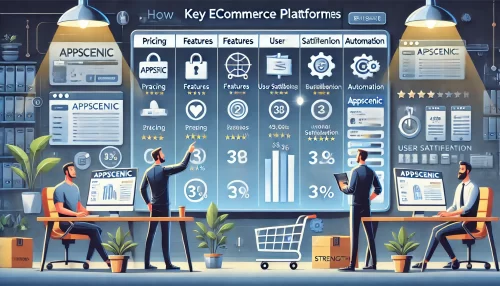
AppScenic operates in a competitive market where platforms like Oberlo and Spocket dominate. To help you decide if AppScenic is the right fit, let’s break down how it compares against these key players in the dropshipping landscape.
AppScenic vs. Oberlo: Key Feature Comparisons
Oberlo has long been a favorite among dropshippers, particularly for those using Shopify. However, AppScenic offers several advantages that make it stand out for users looking for more control and flexibility.
One major difference lies in supplier access. Oberlo mainly relies on suppliers from AliExpress, limiting users to products that often come with long shipping times. AppScenic, on the other hand, connects users to a broader network of verified suppliers, many with warehouses in multiple regions for faster delivery.
Automation is another area where AppScenic shines. While Oberlo provides basic automation for order fulfillment and inventory syncing, AppScenic offers more advanced tools like dynamic pricing and automated order routing. These features help users optimize profits without manual intervention.
Additionally, AppScenic’s real-time inventory syncing across multiple platforms (not just Shopify) is a significant advantage for store owners who want to expand to other ecommerce platforms. Oberlo’s functionality is largely tied to Shopify, limiting flexibility for businesses that aim to scale across multiple channels.
Overall, Oberlo is great for beginners, but AppScenic is ideal for those seeking more scalability and supplier diversity.
AppScenic vs. Spocket: Pros and Cons Breakdown
Spocket is another strong competitor, offering access to suppliers primarily in the US and EU, making it popular among users seeking faster shipping. But how does it compare to AppScenic?
The biggest difference lies in supplier verification and product variety. While Spocket focuses on suppliers within specific regions, AppScenic offers a broader supplier network, including international options for users seeking a wider product range. This allows AppScenic users to cater to global audiences while still maintaining high-quality standards.
Spocket’s strength is its local shipping options, which can be beneficial for ecommerce owners targeting customers in the US and EU. However, AppScenic’s ability to integrate with suppliers across different regions gives it a slight edge in terms of product availability and reach.
Automation features also play a critical role in differentiation. AppScenic’s advanced automation tools—including real-time pricing updates, multi-platform syncing, and fraud detection—go beyond what Spocket offers. These features are particularly valuable for users who want to reduce manual tasks and maximize operational efficiency.
While Spocket is a great choice for region-specific selling, AppScenic offers more versatility for those seeking scalability and automated processes.
What Makes AppScenic Stand Out in the Market
AppScenic’s key differentiators lie in its automation capabilities, extensive supplier network, and platform versatility. Unlike competitors that focus on specific regions or platforms, AppScenic allows users to grow their business globally without being restricted to a single sales channel.
Its dynamic pricing tools, real-time inventory syncing, and automated order fulfillment help users streamline their operations and improve profitability. This combination of automation and supplier diversity makes AppScenic ideal for ecommerce owners looking to expand their store’s reach without increasing manual workload.
Moreover, its fraud detection system and secure payment integrations offer added protection that many competitors don’t provide. This is a critical advantage, especially for store owners concerned about chargebacks or supplier-related issues.
🌟 Pro Tip: If you’re torn between AppScenic, Oberlo, and Spocket, consider your growth goals. For large-scale global expansion, AppScenic’s versatility and automation tools make it the stronger option.
Final Verdict: Is AppScenic the Right Fit for You?
Choosing the right dropshipping platform depends on your business size, growth plans, and operational needs. AppScenic offers a comprehensive suite of features designed to simplify operations while supporting scalability.
Pros and Cons of Using AppScenic
Let’s break down the main advantages and challenges:
Pros:
- Access to a global supplier network for better product variety
- Advanced automation tools, including order fulfillment and price optimization
- Real-time inventory updates across multiple sales channels
- Faster shipping options through verified local suppliers
- Strong security measures to protect customer and payment data
Cons:
- Some users may experience a learning curve when setting up advanced features
- Pricing plans can be expensive for beginners or small stores
While AppScenic provides many benefits, it’s essential to evaluate whether its pricing structure fits your budget and whether you’re ready to utilize its advanced features.
Ideal Use Cases for Ecommerce Owners
AppScenic is particularly well-suited for ecommerce owners looking to:
- Expand their store globally while managing products from multiple suppliers
- Automate repetitive tasks like inventory syncing, order routing, and pricing updates
- Avoid common issues like overselling or dealing with unreliable suppliers
- Offer faster shipping options to maintain customer satisfaction and loyalty
It’s also ideal for mid-sized to large stores that handle high order volumes and need scalable solutions. New dropshippers can start with AppScenic’s free plan, but its real power lies in the features unlocked with paid plans.
My Recommendation Based on User Feedback and Features
Based on user reviews and the platform’s capabilities, AppScenic is a solid investment for ecommerce owners planning long-term growth. Its automation tools can save you hours of manual work, while its supplier network provides flexibility in product offerings.
If you’re running a small store or just starting, test the free plan to get a feel for the platform. Once you’re comfortable and ready to scale, upgrading to a paid plan is worth considering. The ability to automate pricing, fulfillment, and inventory will give you the time and tools needed to focus on growth.
🚀 Best Practice: As your store grows, monitor your manual workload. If you find yourself overwhelmed with tasks like order management or stock updates, AppScenic’s automation could be the key to scaling without hiring additional staff.



